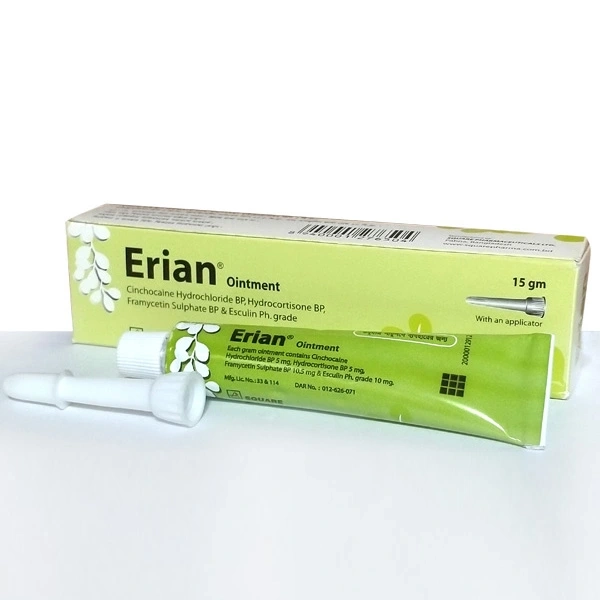Indications
This is indicated for the treatment of-
- Internal and external haemorrhoids
- Haemorrhoids post-partum
- Anal pruritus, peri-anal eczema, anal fissures and proctitis
- Post-haemorrhoidectomy application to relieve pain and discomfort
Composition
Each gram ointment contains-
- Cinchocaine Hydrochloride BP 5 mg
- Hydrocortisone BP 5 mg
- Framycetin Sulphate BP 10.5 mg
- Esculin Ph. grade 10 mg.
- Cinchocaine Hydrochloride BP 5 mg
- Hydrocortisone BP 5 mg
- Framycetin Sulphate BP 10 mg
- Esculin Ph. grade 10 mg.
Pharmacology
The local anaesthetic Cinchocaine Hydrochloride prevents or relieves the severe pain sometimes encountered in strangulated haemorrhoids, fissures and perianal haematomata, whilst the corticosteroid (Hydrocortisone) acts as a decongestant, anti-inflammatory and anti-pruritic agent and by so doing eliminates itching, inflammation and mucous discharge. The broad spectrum antibiotic, Framycetin Sulphate, will eradicate most infections which may already be present or arise in lesions of the anorectal area and Esculin has a skin protective action.
Dosage & Administration
Ointment: Apply the ointment in a small quantity with the finger, on the painful or pruritic area, morning and evening and after each stool. For deep application, insert the cannula or applicator to full extent and squeeze tube gently from lower end whilst withdrawing.
Suppository: A suppository is inserted morning and evening, and after each stool.
Suppository: A suppository is inserted morning and evening, and after each stool.
Contraindications
Known hypersensitivity to any of the four ingredients. Corticosteroids have been shown to be teratogenic in animals following dermal application. As these agents are absorbed percutaneously, teratogenicity following topical application cannot be excluded. Therefore this product should not be used during pregnancy. Topical corticosteroid preparations are contraindicated in the treatment of herpes simplex, vaccinia or varicella, or tuberculous infection of the anal region.
Side Effects
Long-term continuous treatment with topical corticosteroids should be avoided as far as possible as this may cause atrophic changes in the skin leading to thinning, loss of elasticity, dilatation of superficial blood vessels, telangiectasia and ecchymoses. These changes are particularly likely to occur when occlusive dressings are used. Systemic absorption of topically applied corticosteroids may occur, particularly under the following conditions: when large quantities are used or when application is made to wide areas of the body, or to damaged skin; when potent topical corticosteroids are used, and when the occlusive dressing technique is applied. Depression of the hypothalamic-pituitary-adrenal axis with consequent suppression of the adrenal gland may occur. These effects are most likely to be severe in children. Growth may be retarded and a Cushingoid state may be produced. Benign intracranial hypertension has been rarely reported.
Pregnancy & Lactation
The safe use of topical corticosteroids during pregnancy has not been fully established. Therefore, during pregnancy, they should not be used unnecessarily on extended areas, in large amounts or for prolonged periods of time.
Precautions & Warnings
Discontinue use if sensitization occurs. Other specific measures against infections, allergy, and other causal factors must not be neglected. The possibility, however rare, that prolonged use of Erian might produce systemic corticosteroid effects, should be borne in mind. Patients should be advised to inform subsequent physicians of the previous use of hydrocortisone.
Use in Special Populations
Not recommended for use in children.
Therapeutic Class
Compound steroidal preparations, Drugs used in Ano-rectal region
Storage Conditions
Store at a cool and dry place, protected from light. Store below 25° C. Do not freeze.


